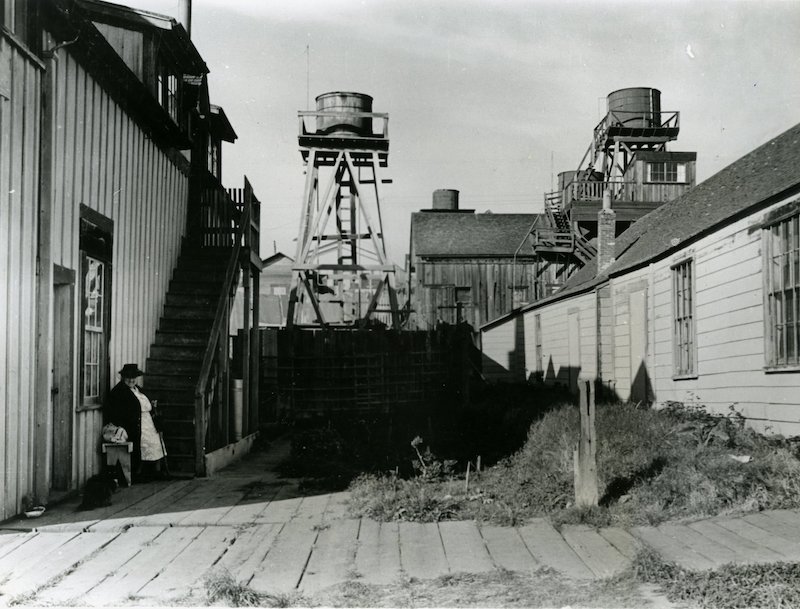August 29, 1887 – H. E. Wilkinson, a clerk for the United States Signal Service, arrived in Mendocino to install a weather station. This station was one of ten set up thru a partnership between the Signal Service and the San Francisco Chronicle. The other locations were San Luis Obispo, Monterey, Santa Rosa, Yreka, San Bernardino, Modesto, Bakersfield, Indio, and Carson City, Nevada.

View of water towers in Mendocino, looking north from Main Street, 1948. The building on the right was originally built by Eugene Brown as a general merchandise store. The water tower at the rear of the Brown store had two tanks (at heights of 20′ and 40′). It served the fire department in that area of town in battling fires. Still visible in this photo is the large storage building that surrounded the tower, with an outside staircase up to a lookout shed with large windows at the top near the upper tank. In earlier years, this tower housed the Signal Service instruments. (Gift of William Heick, photographer)
According to the Chronicle, “The amount of money appropriated for the purpose by the Government limited the number of signal stations in California and thus prevented the full development of the service. The Chronicle offered to pay the expenses of providing additional observers at ten new stations, of instructing the observers in the use of the instruments, and of telegraphing the reports throughout the State, the only outlay of the Government being the loan of the apparatus and the supplying of printed forms.”
Lauriston A. Morgan was in charge of the Mendocino station. The instruments included four thermometers (including maximum and minimum thermometers), a rain gauge, a barometer, a wind vane, and an anemometer for measuring wind speed. Morgan gathered the weather information and relayed the readings to San Francisco by telegraph three times per day.
The Chronicle compiled the information from the stations and sent “the weather indications for the day to every telegraph office in the State of California. Neat bulletin boards were furnished by the Chronicle and the signal service reports were each day posted upon them, accessible to all interested in the probable changes of the weather.”
In 1891, Congress moved the weather bureau from the Signal Service to the Department of Agriculture, and the partnership ended. The Beacon reported that the weather service “has been discontinued at this place, and now the anemometer and wind vane that were on E. Brown’s water tower no longer cater to the elements. They have been shipped to San Francisco.”
Walking Tours of Historic Mendocino – Join our expert docents for a stroll and lively commentary. You’ll pass by early pioneer homes, historic meeting places, and buildings that make up the the Mendocino Historic District.